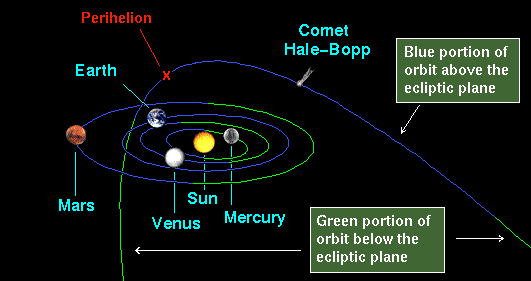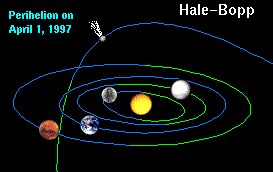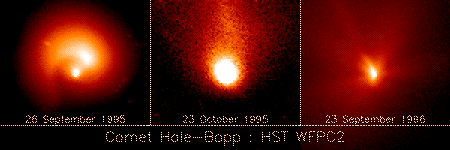 |
Comet Hale-Bopp, December 16, 1996 |
Hale-Bopp is a long-period comet that was discovered in 1995 and that reached perihelion in Spring, 1997. Because it was much brighter than comets normally are when it was first discovered outside the orbit of Jupiter, there was considerable speculation that in the Spring of 1997 Hale-Bopp would be a spectacular sight.
 |
Comet Hale-Bopp, December 16, 1996 |
In this image the orbits are drawn to scale, but the sizes of the planet and comet images (and the length and orientation of the comet tail) are not realistic.
At this time the comet was about 2 A.U. from the Sun and about 2.7 A.U. from the Earth. The color blue indicates portions of orbits that are above the plane of the ecliptic and green indicates portions of orbits that are below the plane of the ecliptic. Notice that Hale-Bopp has an orbit that is either parabolic or highly elliptical, and that its orbit is very far out of the plane of the ecliptic.
 The Inner Solar System on April 1, 1997, with Comet Hale-Bopp at perihelion. |
Comet Hale-Bopp reached perihelion on April 1, 1997, at a
distance of 0.91 A.U. from the Sun and 1.36 A.U. from the Earth.
The image on the left shows the relative positions of objects in the inner solar system on that date. Here is the present position of Comet Hale-Bopp. |
 |
| Hubble Space Telescope Images of Comet Hale-Bopp (1995) |
The left frame shows the comet about 60 hours after a huge outburst of dust; it shows a spiral structure reminescent of a water sprinkler observed from above. The middle frame shows the comet during a more quiescent phase. The right figure shows a more recent image with at least five jets emanating from the nucleus. (Here is an enhanced photograph of at least 7 jets from Hale-Bopp taken at the European Southern Observatory.)
The nucleus of the comet is located at the center of each frame, but most of the light observed is caused by scattered sunlight from the coma of dust emitted from the nucleus.